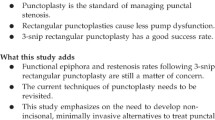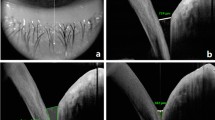Abstract
Purpose
We investigated the etiology of punctal stenosis based on the histopathological features of puncta and clinical correlations in punctal stenosis patients.
Methods
A retrospective review was conducted of 69 cases from 38 patients who were diagnosed with punctal stenosis. Slit-lamp examination, the lacrimal irrigation test, dacryocystography, and spectral domain-optical coherence tomography were performed for the evaluation of punctal occlusions. For treatment, punctoplasty using a punch biopsy with or without silicone tube insertion and histopathological examinations were performed.
Results
The pathological features of the punctal membranes were classified into two types of epithelia: squamous (95.7%, 66/69) and columnar (4.3%, 3/69). The squamous epithelial specimens were divided into three groups: fibrous tissue (66.8%, 48/69), goblet cells (21.8%, 48/69), and keratinization (4.3%, 3/69). Most of the subepithelial pathology was fibrosis (82.6%, 57/69), and inflammation was noted in 17.4% (12/69) of the patients. Subepithelial fibrosis was the most common pathological feature in patients exhibiting stenosis with a squamous epithelium, while inflammation was more strongly correlated with patients with a columnar epithelium. However, there was no correlation between the histopathological findings and treatment outcomes.
Conclusion
Our histopathological findings suggest that primary fibrosis of the stenotic punctum was caused by intrinsic inflammation of the puncta rather than spreading from the conjunctiva or eyelid. Punctoplasty was effective in treating punctal stenosis, regardless of the epithelial type.



Similar content being viewed by others
References
Kakizaki H, Takahashi Y, Iwaki M, Nakano T, Asamoto K, Ikeda H, Goto E, Selva D, Leibovitch I (2011) Punctal and canalicular anatomy: implications for canalicular occlusion in severe dry eye. Am J Ophthalmol 153:229–237
Ansari SA, Pak J, Shields M (2005) Pathology and imaging of the lacrimal drainage system. Neuroimaging Clin N Am 15:221–237
Port AD, Chen YT, Lelli GJ Jr (2013) Histopathologic changes in punctal stenosis. Ophthalmic Plast Reconstr Surg 29:201–204
Ali MJ, Mishra DK, Baig F, Lakshman M, Naik MN (2015) Punctal stenosis: histopathology, immunology, and electron microscopic features-a step toward unraveling the mysterious etiopathogenesis. Ophthalmic Plast Reconstr Surg 31:98–102
Hur MC, Jin SW, Roh MS, Jeong WJ, Ryu WY, Kwon YH, Ahn HB (2017) Classification of lacrimal punctal stenosis and its related histopathological feature in patients with epiphora. Korean J Ophthalmol 31:375–382
Keith CG (1968) Intubation of the lacrimal passages. Am J Ophthalmol 65:70–74
Wong ES, Li EY, Yuen HK (2017) Long-term outcomes of punch punctoplasty with Kelly punch and review of literature. Eye (Lond) 31:560–565
Hurwitz JJ (1996) Disease of the punctum. In: Hurwitz JJ (ed) The Lacrimal System. Lippincott-Raven, Philadelphia, pp 149–153
Sadiq SA, Downes RN (1998) Epiphora: a quick fix? Eye (Lond) 12:417–418
Shahid H, Sandhu A, Keenan T, Pearson A (2008) Factors affecting outcome of punctoplasty surgery: a review of 205 cases. Br J Ophthalmol 92:1689–1692
Chak M, Irvine F (2009) Rectangular 3-snip punctoplasty outcomes: preservation of the lacrimal pump in punctoplasty surgery. Ophthal Plast Reconstr Surg 25:134–135
Sung Y, Park JS, Lew H (2017) Measurement of lacrimal punctum using spectralis domain anterior optical coherence tomography. Acta Ophthalmol 95:e619–e624
Heindl LM, Jünemann AG, Kruse FE, Holbach LM (2010) Tumors of the lacrimal drainage system. Orbit 29:298–306
Heindl LM, Junemann A, Holbach LM (2009) A clinicopathologic study of nasal mucosa in 350 patients with external dacryocystorhinostomy. Orbit 28:7–11
Kashkouli MB, Beigi B, Murthy R, Astbury N (2003) Acquired external punctal stenosis: etiology and associated findings. Am J Ophthalmol 136:1079–1084
Yuen SJ, Oley C, Sullivan TJ (2004) Lacrimal outflow dysgenesis. Ophthalmology 111:1782–1790
Kornhauser T, Segal A, Walter E, Lifshitz T, Hartstein M, Tsumi E (2019) Idiopathic edematous punctal stenosis with chronic epiphora: preponderance in young women. Int Ophthalmol 39:1981–1986
Kominami R, Yasutaka S, Taniguchi Y, Shinohara H (2000) Anatomy and histology of the lacrimal fluid drainage system. Okajimas Folia Anat Jpn 77:155–160
Reddy AK, Baker MS, Maltry AC, Syed NA, Allen RC (2017) Immunopathology and histopathology of conjunctival biopsies in patients with presumed idiopathic punctal stenosis. Br J Ophthalmol 101:213–217
Singh S, Rajput A, Mohamed A, Mittal V (2018) Spectral domain optical coherence tomography for measuring tear film meniscus height and its relationship with epiphora. Indian J Ophthalmol 66:1592–1594
Do JR, Lee H, Baek S, Lee TS, Chang M (2016) Efficacy of postoperative mitomycin-C eye drops on the clinical outcome in endoscopic dacryocystorhinostomy. Graefes Arch Clin Exp Ophthalmol 254:785–790
Liao SL, Kao SC, Tseng JH, Chen MS, Hou PK (2000) Results of intraoperative mitomycin C application in dacryocystorhinostomy. Br J Ophthalmol 84:903–906
Cheng SM, Feng YF, Xu L, Li Y, Huang JH (2013) Efficacy of mitomycin C in endoscopic dacryocystorhinostomy: a systematic review and meta-analysis. PLoS One 8:e62737
Rubinfeld RS, Pfister RR, Stein RM, Foster CS, Martin NF, Stoleru S, Talley AR, Speaker MG (1992) Serious complications of topical mitomycin-C after pterygium surgery. Ophthalmology 99:1647–1654
Author information
Authors and Affiliations
Corresponding author
Ethics declarations
Conflict of interest
The authors declare that they have no conflict of interest.
Ethical approval
All procedures performed in studies involving human participants were in accordance with the ethical standards of the institution review board and with the 1964 Helsinki declaration and its later amendments or comparable ethical standards. This article does not contain any studies with animals performed by any of the authors.
Informed consent
Informed consent was obtained from all individual participants included in the study.
Additional information
Publisher’s note
Springer Nature remains neutral with regard to jurisdictional claims in published maps and institutional affiliations.
Rights and permissions
About this article
Cite this article
Jang, J.K., Lee, S.M. & Lew, H. A histopathological study of lacrimal puncta in patients with primary punctal stenosis. Graefes Arch Clin Exp Ophthalmol 258, 201–207 (2020). https://doi.org/10.1007/s00417-019-04514-9
Received:
Revised:
Accepted:
Published:
Issue Date:
DOI: https://doi.org/10.1007/s00417-019-04514-9




